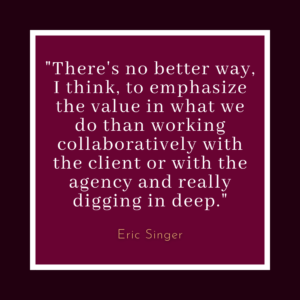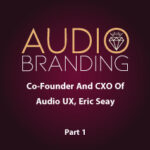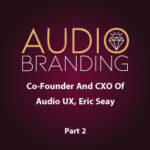“There are generally two things that I want to focus on when presenting the creative to a client. First, and I think the most important, is the why: what is the justification for why we have done this or why we’ve included this instrument, why we’re including this long breakdown section, why this tempo, whatever it is.” — Eric Singer
 My guest’s first love in this episode was audio, but it took him a while to get back to it. He’s been with Coupe Studios for sixteen years, and before that he spent time as a magazine editor, a photographer, and even a semi-pro football player. Now a partner at Coupe, he’s focusing specifically on sonic branding and music for advertising and film. His name is Eric Singer, and I’m looking forward to hearing what he has to say about where audio branding is now and where it’s heading into the future.
My guest’s first love in this episode was audio, but it took him a while to get back to it. He’s been with Coupe Studios for sixteen years, and before that he spent time as a magazine editor, a photographer, and even a semi-pro football player. Now a partner at Coupe, he’s focusing specifically on sonic branding and music for advertising and film. His name is Eric Singer, and I’m looking forward to hearing what he has to say about where audio branding is now and where it’s heading into the future.
How does he let their clients know that their audio is important? How does Coupe Studios differentiate itself in a steadily growing audio-forward market? If you’re trying to decide why audio branding is important for your company, this discussion will give you a firsthand look.
As always, if you have any questions for my guest, you’re welcome to reach out through the links in the show notes. If you have questions for me, just visit www.audiobrandingpodcast.com where you’ll find all sorts of ways to get in touch. Plus, subscribing to the newsletter (on the www.audiobrandingpodcast.com webpage) will let you know when the new podcasts are available.
A Multisensory Experience
We begin the interview with Eric’s account of his earliest memories of sound, a Fischer-Price turntable that he used as a child to play the classic Beatles album Sgt. Pepper’s Lonely Hearts Club Band. As he puts it, its unconventional sound design and ambient effects “planted the seed for me in terms of a love of audio.” He goes on to recount his very first experience as a radio DJ during high school. “It was this multisensory experience,” he says, “where you’re looking at the album art [and] you’re reading the liner notes. The center of it was the music, but I loved talking about it just as much.”
Digging in Deep
Eric tells us about how he discovered his affinity for editing and production, and how it led to his role as an audio producer. “We have this extremely talented, dedicated team of composers and sound designers,” he explains, “and my job is to stay out of their way.” We talk about how he works with clients to help them understand and navigate the sometimes overwhelming process of finding just the right creative strategy. “There’s no better way, I think, to emphasize the value in what we do than working collaboratively with the client or with the agency and really digging in deep.”
 Flying Below the Radar
Flying Below the Radar
Next, we look at the process of building a sonic brand for a client, whether it’s a new company that’s starting from scratch or a major brand like McDonald’s with an established audio brand. Eric explains that a new brand can offer more room to create a unique sonic identity: as he puts it, “it’s nice in the sense that we can often get involved before they’ve really thought things through.” We also talk about how easily audio is overlooked, and how that can sometimes be as much an opportunity as a challenge. “It’s a tricky position to be in,” he says, “but it’s also kind of fun to fly below the radar.”
The Emotional Aspect
“The second piece of it,” Eric says about the two parts of creating a sonic brand, “is the emotional and the subjective aspects of it.” We discuss how individual experiences and impressions, everything from cultural nuance to an unpleasant memory, can have a powerful impact. “The idea of something totally subjective killing a really great piece of work can be really scary,” he says while telling us how he guides clients in making the right decisions when it comes to crafting a unique brand.
Episode Summary
- Eric’s early experiences with radio production and advertising
- The secret to being a successful creative producer
- The importance of practical and original sound elements
- Designing a new sound vs. working with an existing brand
- Navigating the subjective side of audio composition
Check back next week for part two of our interview as Eric and I talk about how our post-pandemic world has changed his presentation strategy, how Coupe Studios works to support indie bands as well as sonic branding, and some of the most cutting-edge developments in audio technology.
Connect with the Guest
Website: https://coupestudios.com/
Connect with Eric Singer on LinkedIn: https://www.linkedin.com/in/eric-singer-audio/
Get your complimentary mini e-book and learn how to create your personalized and branded audio branding strategy with my Top Five Tips for Implementing an Intentional Audio Strategy.
Do you need a voice talent for your next project? Visit my voice-over website to find out more about how my voice can help you with your audio brand. You can also subscribe to the Audio Branding Podcast on YouTube to watch the show’s latest episodes.
Please leave the Audio Branding Podcast a written review or a spoken review so others can find the show on their favorite podcast player!
This interview episode was very skillfully made to sound beautiful by the talented Humberto Franco.


